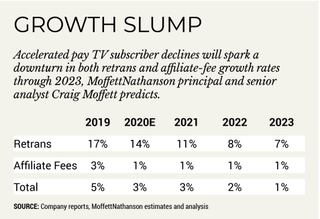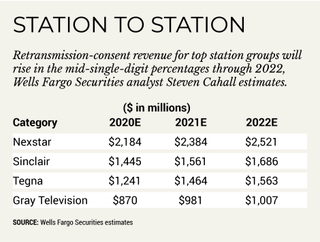Virus Takes a BiteOut of Fee Growth
Pay TV video-subscriber losses, fueled in part by the economic uncertainties surrounding the pandemic, reached a record high in the first quarter and are expected to get bigger, leaving exposed two of the largest revenue segments for programmers —
retransmission consent and affiliate fees.
Retrans and affiliate fees have grown exponentially over the past decade, but growth has slowed over the past several quarters. As more and more households disconnect their pay TV service, the impact could be hard on programmers that have come to rely on those revenue streams to offset declines in the advertising market.
Affiliate-fee growth was anemic in the first quarter, with Turner, Fox, The Walt Disney Co. and Discovery reporting modest increases, while NBCUniversal, ViacomCBS and AMC Networks all declined. For national broadcasters, retrans fee growth was about 15% in Q1, down from a 22% increase in the same period last year.
High Sub Losses
About 2 million customers cut the pay TV cord in Q1, the worst quarter ever for cable, satellite and now virtual multichannel video programming distributors (MVPDs) such as Sling TV. The bulk of those losses came from AT&T’s satellite-TV provider, DirecTV (897,000), and Dish Network (413,000). But traditional cable operators, who have seen video customers decline for more than a decade, also saw increased losses. Overall, pay TV subscribers fell by 7.6%, the highest rate of decline ever.

Comcast lost about 409,000 video customers in Q1, more than three times the 120,000 it lost in the year-ago period. Altice USA lost about 42,000 video customers in the quarter, four times the 10,000 losses it had in Q1 2019. Charter Communications, the No. 2 U.S. cable operator behind Comcast, was the exception, managing to escape the quarter with 71,000 video losses, less than half the 152,000 it shed in the prior year.
Though pay TV subscribers were in decline well before COVID-19, MoffettNathanson principal and senior analyst Craig Moffett said in a research report, the pandemic has helped accelerate the fall. While some point to a lack of live sports programming as professional and college sports all suspended or canceled their seasons, Moffett wasn’t too optimistic those lost customers would return when live games resume.
Multichannel Newsletter
The smarter way to stay on top of the multichannel video marketplace. Sign up below.
“Does anyone think that when sports come back those customers will return to pay TV (either traditional or vMVPD)?” Moffett asked. “We doubt it. The underlying causes for the defections are not transitory. The transitory factors are just pulling forward the defections.”
Retrans and cable network affiliate-fee growth will continue to decline over the next three years, Moffett predicted, as pay TV customers cut the cord. In his report, he estimated retrans growth would drop to 14% in 2020 from 17% in 2019 and to 7% by 2023. Affiliate-fee growth, at about 3% in 2019, would slow to 1% in 2020 and to minus 1% by 2023, according to Moffett.
At Kagan, a research unit of S&P Global Market Intelligence, senior research analyst Justin Nielson also predicted that faster declines in video subscriber growth would have an effect on retrans. In his “bear case” scenario — estimating traditional subscribers decline by 12% for the year and vMVPDs gain 8% — gross retrans and virtual subscriber fees would fall 3% to $12 billion in 2020.
In Kagan’s “middle of the road” scenario, where MVPDs decline 10% and vMVPDs rise 12%, retrans and virtual subscriber fees would be relatively flat at $12.6 billion in 2020. The “bull case” — less likely with the recent results — predicted that retrans revenue would grow 6% and traditional pay TV subscribers would fall 8% as live sports returns and people return to work.
The pandemic has made it difficult to predict the future, with every major cable network and broadcaster having pulled back prior guidance for the year. But Kagan’s Nielson said broadcasters may fare better because many of them had struck multi-year deals before the pandemic hit.
At Nexstar Media Group, the largest broadcaster in the country with 196 stations, chairman CEO Perry Sook said on a Q1 analyst call that Nexstar has modeled out pay TV subscriber attrition into overall projections and, so far, they have come in better than assumptions.

“So it is not like sub declines are sneaking up on anybody here,” Sook said on the May 6 call.
There could be some concerns that consumers would drop pay TV subscriptions because they can’t pay for them, Sook said. But that isn’t a factor now, because most distributors have pledged not to disconnect for nonpayment for at least the next few months.
At Sinclair Broadcast Group, which owns more than 190 TV stations and 23 regional sports networks across the country, the situation is a little dicier.
Retrans revenue for Sinclair was up 11% in the period to $355 million, about even with the 11.5% gain in the 2019 quarter. In a research note, Wells Fargo Securities analyst Steven Cahall estimated that Sinclair’s retrans revenue would be up about 5% for the year.
Sinclair’s High Exposure
Cahall downgraded Sinclair to “underweight” on May 4, based on its high exposure to affiliate fees and retrans: 68% of total revenue comes from those sources, compared to 50% for Nexstar.
“A recession will likely exacerbate cord-cutting,” Cahall wrote in his downgrade note, adding that retrans growth could be lower because of a need to secure carriage for the RSNs.
“We think rates could trend towards the lower end of the broadcast peer group in part because we think [Sinclair] may be less aggressive on retrans with MVPDs in order to support RSN carriage with MVPDs,” Cahall wrote. “This would be throwing good money after bad, in our view.”
